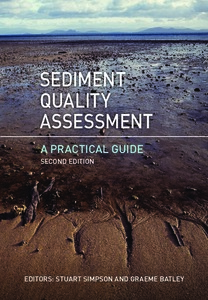| dc.description.abstract | The last decade has seen an exponential growth in our understanding of the forms, fate
and effects of contaminants in sediments. In Australia, as in many parts of the world,
sediment quality guidelines are now well established in regulatory frameworks. However,
detailed guidance on how to interpret and apply the guidelines is generally limited. It is
recognised that additional research is needed to resolve several uncertainties in the science
underpinning sediment quality guidelines. In Australia and New Zealand, the approach
has been to introduce a tiered assessment framework so that exceedance of the sediment
quality guideline value leads to additional studies to confirm or deny the possibility of
biological impacts. This approach is outlined in the Australian and New Zealand guidelines for fresh and marine water quality, published in 2000.
In 2010, the sediment quality guidelines for Australia and New Zealand were revised
(by the editors and an author of the present volume). The revision introduces the use of
multiple lines of evidence in a weight-of-evidence approach to the assessment. This is consistent with similar developments internationally. The approach extends the current
decision framework so that it provides a means, where necessary, of combining lines of
evidence. For example, bioaccumulation and ecological assessments can now be combined
with the traditional chemistry and laboratory toxicity lines of evidence, and there is now a
mechanism for bringing in additional information on chemical exposure and bioavailability which can improve assessments of causality.
Thus, now, investigations should ideally combine assessments of:
● sediment chemistry (such as exceedances of sediment quality guidelines), including
contaminant bioavailability tests (for example, pore-water measurements, acid
volatile sulfide tests, passive sampling methods and approaches that mimic biotic
responses to hydrophobic organic contaminants);
● toxicity testing (for example, of multiple species, varying exposure pathways, and
acute and chronic endpoints such as survival, growth, reproduction or avoidance,
and biomarkers of effects);
● bioaccumulation or biomagnification; and
● benthic community structure and function.
Toxicity identification evaluation (TIE) and other assessments of causality may also be
of value. The combination and interaction between lines of evidence should be considered
in applying these in a weight-of-evidence framework (for instance, particle size affects
contaminant bioavailability, and bioavailability test results will affect the interpretation of
toxicity and bioaccumulation data). Weight-of-evidence assessments often ultimately rely
on best professional judgment, but the use of tabular decision matrices is the best approach
for achieving transparency and comprehension by personnel outside the field of ecological
risk assessment.
viii Sediment Quality Assessment
Environmental practitioners are seeking guidance on how to incorporate the latest
science in their assessment of contaminated sediments, while relating their investigations
to the recommended guideline frameworks, and proposed new or revised guideline values
for sediment quality, at a time when the science is still being developed. This handbook
therefore attempts to summarise the advances and provide information to guide future
sediment quality assessment investigations.
The book both reviews the existing literature and recommends best ways to apply these
findings, while describing approaches for measuring the various lines of evidence. As new
lines of evidence are continuing to be developed, future sediment quality assessments may
also incorporate those. A general approach is proposed, recognising that assessments frequently need to be custom-designed and lines of evidence chosen to suit the site-specific
circumstances (such as site dynamics, sediment stability, groundwater flows, and fluctuating overlying water conditions).
The focus on sediment quality assessment, at least in Australia, has largely been in
estuarine and coastal marine environments, but the principles are equally applicable to
freshwater systems, and guidance is therefore also provided in this book for freshwater
toxicity testing and ecological assessment procedures for freshwater environments. | en_US |
 Repository of community practices in Ocean Research, Applications and Data/Information Management
Repository of community practices in Ocean Research, Applications and Data/Information Management

